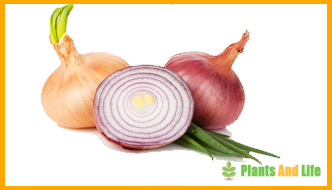
The onion or onion (Allium cepa), pronounced /ɔ.ɲɔ̃/, is a species of biennial herbaceous plants of the family Amaryllidaceae, widely and for a long time cultivated as a vegetable plant. The term also designates the bulb of this plant harvested as a vegetable. By extension, it sometimes colloquially refers to the bulbs of other plants, generally inedible, when gardening (for example: tulip onion).
The onion is used both as a vegetable and as a condiment.
The onion bulb consists of thickened bases of leaves wrapped in each other. In general, we speak of onion for all liliaceous bulbs, such as tulips.
The shallot is a plant very similar to the onion but it has a higher number of vegetative points per bulb.
Description
The onion is a herbaceous species, perennial by its single bulb, cultivated as an annual or biennial (flowering the second year). It is a tall plant of 60 to 100 cm, whose green leaves are cylindrical, hollow (which distinguishes this species from leek and garlic, other cultivated species also belonging to the genus Allium). The upright flower stem is also hollow. It has a bulge towards its base.
The bulb is relatively large, spherical in shape, sometimes more or less flattened.
The small flowers (4 to 5 mm wide), white or green in color, are grouped in a spherical umbel, in the terminal position on the stem. The flowers have a trimer symmetry, with three sepals, three petals and six stamens. The single ovary is divided into three lodges. The fruit is a capsule opening by three valves, each generally releasing two seeds. There can be about 600 flowers per umbel.
In some varieties, bulbs may develop instead of flowers.
The seeds are black, angular. There are about 250 seeds per gram. The duration of germination is short (2 years).
Varieties
More than 1,000 varieties of onions (or stumps) are listed in the European Catalog of Species and Varieties. Among these, nearly 50 varieties are listed in the French Official Catalog, including 3 on the SVI list (previously list of old varieties for amateurs).
 Protected names
Protected namesIn France, the sweet Cévennes onion obtained the AOC label in 2003. The Roscoff onion received this label on October 22, 2009 (pink logo with the white acronym of the National Institute of Origin and Quality below). The Roscoff pink onion merchants who crossed the Channel every year to sell them in the South of Great Britain were called the "Johnnies".
In Spain, Cebolla Fuentes de Ebro (es) (onion from the sources of the Ebro) was the subject of a PDO classification request in 2009, granted at the end of 2010. The appellation covers around 150 ha in six municipalities, including the Fuentes de Ebro, located in the province of Zaragoza (Aragon).
In Italy, the cipollotto nocerino (it) (small onion of the Agro nocerino-sarnese (it) in Campania) has been classified AOP since 2008 and the Cipolla Rossa di Tropea Calabria (red onion from Tropea - Calabria) has also been classified PGI 2008.
Cooked
The more finely chopped the onion, the faster it cooks; it then changes flavor.
The red onion has a lighter taste with a slightly sweeter flavor than that of the yellow onion. It is recommended raw in salads and raw vegetables (cooking makes it more bland), but you can also put a few slices in a burger or on a pizza

